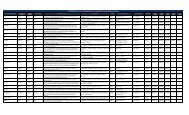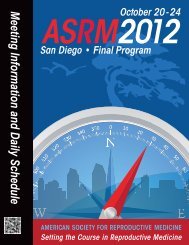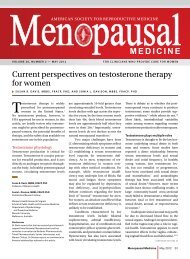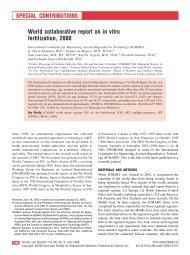scientific program • symposia - American Society for Reproductive ...
scientific program • symposia - American Society for Reproductive ...
scientific program • symposia - American Society for Reproductive ...
You also want an ePaper? Increase the reach of your titles
YUMPU automatically turns print PDFs into web optimized ePapers that Google loves.
SCIENTIFIC PROGRAM <strong>•</strong> SYMPOSIA<br />
Wednesday, October 19, 2011 5:15 pm – 5:45 pm<br />
<strong>Society</strong> <strong>for</strong> Male Reproduction and Urology Mini-Symposium<br />
2010 WHO SPERM REFERENCE VALUES - CLINICAL<br />
SIGNIFICANCE OF COUNT, MOTILITY AND MORPHOLOGY<br />
Edmund S. Sabanegh, Jr., M.D.<br />
Cleveland Clinic<br />
Needs Assessment and Description<br />
Semen analysis is one of the most basic, yet important,<br />
tests <strong>for</strong> assessing the reproductive function in men and<br />
often is utilized during the course of evaluating men <strong>for</strong><br />
subfertility/infertility. Over the past 30 years, the World Health<br />
Organization (WHO) Manual <strong>for</strong> the Examination of Human<br />
Semen has been recognized as providing global standards<br />
<strong>for</strong> semen analysis and has been used extensively by<br />
research and clinical laboratories throughout the world. The<br />
2010, 5th edition, provides revisions, additional explanations<br />
and supporting evidence <strong>for</strong> methods of analysis. Based<br />
on data of the semen quality of fertile men, whose partners<br />
had a time to pregnancy of 12 months or less, the manual<br />
gives the 5th centile as the lower reference limit along<br />
with the complete distribution <strong>for</strong> each semen parameter.<br />
This session, designed <strong>for</strong> physicians and allied healthcare<br />
professionals with an interest in male fertility, will provide an<br />
update of the 2010 WHO Reference Values, focusing on the<br />
clinical significance of count, motility, and morphology.<br />
Room 330 D<br />
81<br />
Learning Objectives<br />
At the conclusion of this interactive session, participants<br />
should be able to:<br />
1. Identify the major changes in the 2010 WHO Manual <strong>for</strong><br />
the Examination of Human Semen.<br />
2. Describe the clinical significance of sperm count, motility<br />
and morphology and the implications <strong>for</strong> infertility.<br />
ACGME COMPETENCY<br />
Medical Knowledge<br />
Patient Care<br />
TEST QUESTION:<br />
In the 2010 (5th) edition of the WHO Manual <strong>for</strong> the<br />
Examination of Human Semen, the lower threshold limits <strong>for</strong><br />
sperm concentration/motility/morphology are:<br />
A. 20 million/mL; 40% total motile/15%<br />
B. 20 million/mL; 50% progressive; 15%<br />
C. 15 million/mL; 40% total motile; 15%<br />
D. 15 million/mL; 32% progressive; 4%








